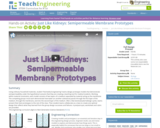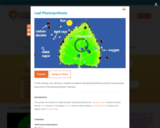
Explore plant and animal cells with this interactive site. Explanations are provided for each cell organelle.
- Subject:
- Science
- Material Type:
- Lesson
- Provider:
- Cells Alive
- Date Added:
- 08/07/2023

Explore plant and animal cells with this interactive site. Explanations are provided for each cell organelle.

A complete, web-based, multi-media textbook which serves as a comprehensive overview of Biology concepts.
A free CK-12 account is required to view all materials.

Student teams learn about engineering design of green fluorescent proteins (GFPs) and their use in medical research, including stem cell research. They simulate the use of GFPs by adding fluorescent dye to water and letting a flower or plant to transport the dye throughout its structure. Students apply their knowledge of GFPs to engineering applications in the medical, environmental and space exploration fields. Due to the fluorescing nature of the dye, plant life of any color, light or dark, can be used unlike dyes that can only be seen in visible light.

In this lesson students will plant and care for soybeans under one of three different photoperiod regimes: First month: 16 hours; Second month: 14 hours; third month: 12 hours (control). 16 hours for all three months (long days). * 12 hours for all three months (short days)
As the plants grow, students will analyze and maintain records of their plant’s progress. This unit features 2 lessons and 7 files. Lessons are aligned to NGSS.

Students set up and run the experiments they designed in the Population Growth in Yeasts associated lesson, using simple yeast-molasses cultures in test tubes. Population growth is indicated by the amount of respiration occurring in the cultures, which in turn is indicated by the growth of carbon dioxide bubbles trapped within the culture tubes. Using this method, students test for a variety of environmental influences, such as temperature, food supply and pH.

Listen and learn how the battery converts energy using voltaic cells. Learn how anodes and cathodes aid in oxidation and reduction. Discover how voltage and electrolysis direct the current.

Students learn about complex networks and how to use graphs to represent them. They also learn that graph theory is a useful part of mathematics for studying complex networks in diverse applications of science and engineering, including neural networks in the brain, biochemical reaction networks in cells, communication networks, such as the internet, and social networks. Students are also introduced to random processes on networks. An illustrative example shows how a random process can be used to represent the spread of an infectious disease, such as the flu, on a social network of students, and demonstrates how scientists and engineers use mathematics and computers to model and simulate random processes on complex networks for the purposes of learning more about our world and creating solutions to improve our health, happiness and safety.

Using ordinary household materials, student “biomedical engineering” teams design prototype models that demonstrate semipermeability under the hypothetical scenario that they are creating a teaching tool for medical students. Working within material constraints, each model consists of two layers of a medium separated by material acting as the membrane. The competing groups must each demonstrate how water (or another substance) passes through the first layer of the medium, through the membrane, and into the second layer of the medium. After a few test/evaluate/redesign cycles, teams present their best prototypes to the rest of the class. Then student teams collaborate as a class to create one optimal design that reflects what they learned from the group design successes and failures. A pre/post-quiz, worksheet and rubric are provided.

Through two lessons and five activities, students explore the structure and function of cell membranes. Specific transport functions, including active and passive transport, are presented. In the legacy cycle tradition, students are motivated with a Grand Challenge question. As they study the ingress and egress of particles through membranes, students learn about quantum dots and biotechnology through the concept of intracellular engineering.

This NetLogo model of leaf photosynthesis shows the macroscopic outcome of the reaction.

Learn about the human body's immune response to pathogens.
A free CK-12 account is required to view all materials.

Explore the specific reactions that happen during the cellular respiration process.
A free CK-12 account is required to view all materials.

Students create large-scale models of microfluidic devices using a process similar to that of the PDMS and plasma bonding that is used in the creation of lab-on-a-chip devices. They use disposable foam plates, plastic bendable straws and gelatin dessert mix. After the molds have hardened overnight, they use plastic syringes to inject their model devices with colored fluid to test various flow rates. From what they learn, students are able to answer the challenge question presented in lesson 1 of this unit by writing individual explanation statements.

Students obtain a basic understanding of microfluidic devices, how they are developed and their uses in the medical field. After conducting the associated activity, they watch a video clip and learn about flow rate and how this relates to the speed at which medicine takes effect in the body. What they learn contributes to their ongoing objective to answer the challenge question presented in lesson 1 of this unit. They conclude by solving flow rate problems provided on a worksheet.

This is a cell biology course exam for mitosis and meiosis. Answers are NOT provided.

Students perform an activity similar to the childhood “telephone” game in which each communication step represents a biological process related to the passage of DNA from one cell to another. This game tangibly illustrates how DNA mutations can happen over several cell generations and the effects the mutations can have on the proteins that cells need to produce. Next, students use the results from the “telephone” game (normal, substitution, deletion or insertion) to test how the mutation affects the survivability of an organism in the wild. Through simple enactments, students act as “predators” and “eat” (remove) the organism from the environment, demonstrating natural selection based on mutation.

A lesson plan that introduces students to the concept of classifying objects as either living or non-living. From this lesson, students begin to think about the necessary characteristics of life.

This lesson will give a general overview of how organelles help a cell function and will explain the importance of organelles in increasing surface area to volume ratios. It is 3 of 3 in the series titled "Organelles."

Insert channels in a membrane and see what happens. See how different types of channels allow particles to move through the membrane.